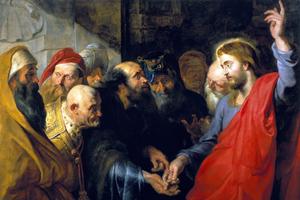Apostolic Ambitions, and the Wife and Sons of Zebedee
SCRIPTURES & ART: Following Jesus was clearly a family affair in the house of Zebedee.

You can say a lot of things about the Apostles but (at least according to St. Mark’s Gospel) one thing’s for sure: They don’t lack ambition. Last month, Peter was rebuked for wanting Jesus to save mankind on Peter’s terms (i.e., salvation without the cross) rather than the Father’s. Also last month, Jesus had to take a child in hand to get the Apostles to break off their debate about their “greatness.”
They’re back at it.
In today’s Gospel, the brothers James and John are asking Jesus to “sit on your right and left hand in glory.”
Every Sunday we proclaim our faith in Jesus who “is seated at the right hand of the Father, whence he will come again in glory to judge the living and the dead.”
God’ right hand is the place of his power and glory. The Jews knew that, which was why when Stephen saw “heaven open and the Son of Man standing at the right hand of God” (Acts 7:56; cf. Daniel 7:13-14, Matthew 26:63-68) they stoned him.
Throughout the past year, Mark has repeatedly invoked the “Messianic Secret,” i.e., telling the beneficiaries of Jesus’s healings, exorcisms, and other miracles not to speak of what happened “until the Son of Man is raised from the dead.” Jesus is aware of the political overtones of Messianic expectations in his day, and does not want to encumber his mission of salvation with those temporal barnacles. Jesus’ followers are unprepared to speak of him accurately until his Passion, Death, and Resurrection, i.e., until — as Paul Harvey used to put it — they had “the rest of the story.”
Jesus’s identity is incomprehensible apart from his Passion, Death and Resurrection. That’s why Peter earns a rebuke. That’s why Jesus repeatedly has to interrupt his Apostles’ callow speculations about their importance.
That didn’t stop James and John.
When, despite his repeated injunctions, James and John persist in their quest for club seating at what they judge to be the great apocalyptic Super Bowl, Jesus immediately connects what they’re asking for with his identity. “Can you drink the cup that I drink or be baptized with the baptism with which I am baptized?” Their jejune answer is: “yes.”
Well, they will. James will die a martyr and John, although traditionally the last Apostle to die, will stand beneath his Master’s cross until the bitter end.
Needless to say, the efforts of the sons of Zebedee to obtain seats on the eschatological 50-yard line does not endear them to the other Apostles. On top of Jesus’ own awareness of his impending Passion, he had to contend with 11 immaturely ambitious men and a thief who likely faulted Jesus for lacking it.
Mark presents James and John as ambitious self-starters, themselves asking Jesus for upgrades in Last Judgment seating. Matthew (20:20-28) presents us with an analogous scene, in which it is the mother of James and John that makes the request for her sons’ status. The two are not mutually exclusive, as there’s no lack of apostolic ambition in the Synoptic Gospels.
This week’s painting depicts the scene from Matthew’s perspective. Veronese’s oil painting, “Christ Meets the Wife and Sons of Zebedee,” dates from around 1565 and currently hangs in Grenoble, France.
Active during the 16th century in and around Venice, Paolo Caliari took the name “Veronese” because of his hometown of Verona. Veronese painted on a grand scale (his works are huge) and composed numerous cycles of Biblical and mythological subjects. By the time Veronese is painting, Italy is in the late Renaissance, awaiting the Baroque: some claim Veronese exhibits features of mannerism, a style of art that tended towards exaggeration and elegance (in contrast to the strict proportions and harmonies of Renaissance painting), although others claim he primarily had his style, especially reflected in his use of color.
Veronese’s painting shows the mother of Zebedee with two very young men in tow, presenting them to Jesus. Tradition holds that John was the youngest of the Apostles but — at least from our perspective — Veronese seems to have exaggerated the youth of Zebedee’s sons, especially when contrasted with the rest of the Apostolic band. The younger (John?) looks expectantly and lovingly, the older (James?) hopefully as one can imagine their good Jewish mother stereotypically putting in “a good word for my boys.” (Perhaps our modern tastes would instead have preferred two older sons slightly embarrassed by their mother’s importunities).
The other five older Apostles don’t look particularly welcomingly on this woman and these upstarts. The one most directly opposite the mother, in orange, strikes a pose of annoyance and frustration. Jesus appears rather with a look of “again?”
The painting reflects the middle period it comes from: Renaissance porticos and architecture but exaggerated elegance and dynamic yet somewhat artificial movement (expressed in the folds of garments one might think a little more refined than those of the average Galilean fisherman). While the figures in the painting are loaded left, their postures and especially their varied head angles (along with the slightly off center columns) create a balance within the leftward shift.
Remember that, in the Gospels, Jesus had selected the sons of Zebedee to be Apostles long before this episode. The mother of James and John appears elsewhere in the Gospels, e.g., as among the women who “had followed Jesus from Galilee to care for his needs” and were witnesses to the crucifixion (Matthew 27:56). Following Jesus was clearly a family affair in the house of Zebedee.
- Keywords:
- Scriptures & Art















